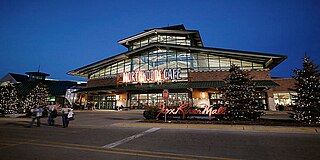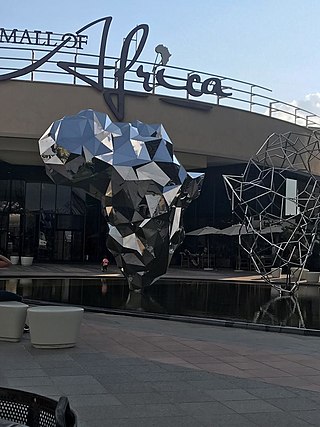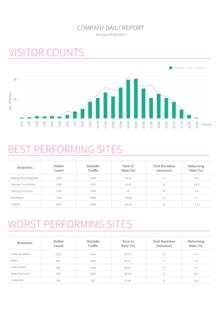
The Toronto Eaton Centre is a shopping mall and office complex in the downtown core of Toronto, Ontario, Canada. It is owned and managed by Cadillac Fairview (CF). It was named after the Eaton's department store chain that once anchored it before the chain went defunct in the late 1990s.

A pedometer, or step-counter, is a device, usually portable and electronic or electromechanical, that counts each step a person takes by detecting the motion of the person's hands or hips. Because the distance of each person's step varies, an informal calibration, performed by the user, is required if presentation of the distance covered in a unit of length is desired, though there are now pedometers that use electronics and software to determine how a person's step varies automatically. Distance traveled can be measured directly by a GPS receiver.

Fox River Mall is an enclosed super-regional shopping center located in Grand Chute, Wisconsin, United States, which serves the Appleton, Wisconsin metropolitan area. It is a major driver of the local economy and its construction helped spur the growth of the Grand Chute shopping district, which is today known as the "shopping capital of Wisconsin". At 1.21 million square feet, it is one of the largest malls in the state.

A hotspot is a physical location where people can obtain Internet access, typically using Wi-Fi technology, via a wireless local-area network (WLAN) using a router connected to an Internet service provider.
Web analytics is the measurement, collection, analysis, and reporting of web data to understand and optimize web usage. Web analytics is not just a process for measuring web traffic but can be used as a tool for business and market research and assess and improve website effectiveness. Web analytics applications can also help companies measure the results of traditional print or broadcast advertising campaigns. It can be used to estimate how traffic to a website changes after launching a new advertising campaign. Web analytics provides information about the number of visitors to a website and the number of page views, or create user behavior profiles. It helps gauge traffic and popularity trends, which is useful for market research.

Digital signage is a segment of electronic signage. Digital displays use technologies such as LCD, LED, projection and e-paper to display digital images, video, web pages, weather data, restaurant menus, or text. They can be found in public spaces, transportation systems, museums, stadiums, retail stores, hotels, restaurants and corporate buildings etc., to provide wayfinding, exhibitions, marketing and outdoor advertising. They are used as a network of electronic displays that are centrally managed and individually addressable for the display of text, animated or video messages for advertising, information, entertainment and merchandising to targeted audiences.
Website popularity is commonly determined using the number of unique users, and the metric is often quoted to potential advertisers or investors. A website's number of unique users is usually measured over a standard period of time, typically a month. "Unique" is a term of art in this context that means distinct and does not count repeat visits or uses by the same person.
Proximity marketing is the localized wireless distribution of advertising content associated with a particular place. Transmissions can be received by individuals in that location who wish to receive them and have the necessary equipment to do so.
Google Store is a hardware retail store operated by Google that sells Google Pixel devices, Google Nest products, Chromecast dongles, Fitbit devices, and accessories such as earbuds, phone cases, chargers, and keyboards. It also sold Nexus, Daydream, Stadia and Cardboard devices until their discontinuations. Google Store sells products made by Google or made in collaboration with that company. It was introduced on March 11, 2015, and replaced the Devices section of Google Play as Google's hardware retailer. It is overseen by Ana Corrales, who is also the COO of Google's Devices & Services division.
Bounce rate is an Internet marketing term used in web traffic analysis. It represents the percentage of visitors who enter the site and then leave ("bounce") rather than continuing to view other pages within the same site. Bounce rate is calculated by counting the number of single page visits and dividing that by the total visits. It is then represented as a percentage of total visits.

An indoor positioning system (IPS) is a network of devices used to locate people or objects where GPS and other satellite technologies lack precision or fail entirely, such as inside multistory buildings, airports, alleys, parking garages, and underground locations.
Mobile web analytics studies the behaviour of mobile website users in a similar way to traditional web analytics. In a commercial context, mobile web analytics refers to the data collected from the users who access a website from a mobile phone. It helps to determine which aspects of the website work best for mobile traffic and which mobile marketing campaigns work best for the business, including mobile advertising, mobile search marketing, text campaigns, and desktop promotion of mobile sites and services.

A traffic count is a count of vehicular or pedestrian traffic, which is conducted along a particular road, path, or intersection. A traffic count is commonly undertaken either automatically, or manually by observers who visually count and record traffic on a hand-held electronic device or tally sheet. Traffic counts can be used by local councils to identify which routes are used most, and to either improve that road or provide an alternative if there is an excessive amount of traffic. Also, some geography fieldwork involves a traffic count. Traffic counts provide the source data used to calculate the Annual Average Daily Traffic (AADT), which is the common indicator used to represent traffic volume. Traffic counts are useful for comparing two or more roads, and can also be used alongside other methods to find out where the central business district (CBD) of a settlement is located. Traffic counts that include speeds are used in speed limit enforcement efforts, highlighting peak speeding periods to optimise speed camera use and educational efforts.

The Core, which consists of TD Square, the Holt Renfrew building, the Simons building, the Stephen Avenue Place shops, Scotia Centre, and the former Calgary Eaton Centre, is the dominant shopping complex located in the downtown core of Calgary, Alberta, Canada. It spans three city blocks and contains approximately 160 retailers on four levels. The property also contains six major office towers (TD Canada Trust Tower, Home Oil Tower, Dome Tower, and the historic Lancaster Building. It is the hub of downtown Calgary's +15 skywalk system, and as such is the busiest shopping centre in the city by pedestrian count, with around 250,000 visitors passing through each week. The centre's architectural focal point is a vast suspended glass skylight which spans the length of the complex. As of October 29, 2010, The Core offers free evening and weekend parking at its underground lots.
In marketing, abandonment rate is a term associated with the use of virtual shopping carts. Also known as "shopping cart abandonment". Although shoppers in brick and mortar stores rarely abandon their carts, abandonment of virtual shopping carts is quite common. Marketers can count how many of the shopping carts used in a specified period result in completed sales versus how many are abandoned. The abandonment rate is the ratio of the number of abandoned shopping carts to the number of initiated transactions or to the number of completed transactions.
Mobile location analytics (MLA) is a type of customer intelligence and refers to technology for retailers, including developing aggregate reports used to reduce waiting times at checkouts, improving store layouts, and understanding consumer shopping patterns. The reports are generated by recognizing the Wi-Fi or Bluetooth addresses of cell phones as they interact with store networks.

Beaugrenelle is a shopping mall located in the 15th arrondissement of Paris, close to the Seine and 10 minutes' walk from the Eiffel Tower. It is one of the biggest shopping malls in Paris' inner city. A mix between a department store and a shopping mall, Beaugrenelle is home to 120 shops and restaurants.

Mall of Africa is a shopping mall located in Waterfall City, Midrand, Gauteng. It is the third largest single-phase shopping mall to be built in Africa, but smaller than Gateway, Sandton City, Menlyn Park and Fourways Mall. The total retail area is 130 000 square metres. The shopping mall has two main levels of shopping as well as an outdoor restaurant plaza which connects directly to the Waterfall City Park.
Aislelabs Inc. is a Toronto-based technology company offering WiFi analytics and marketing platforms.

GrayMatter Software is a data science, artificial intelligence, and analytics firm, headquartered in Bangalore, Karnataka. It was founded in 2006 by Vikas Gupta as a business intelligence consulting firm. Over the years, the company has partnered with SAP, Hitachi Vantara and Qlik for products and services within the airport Industry.
















